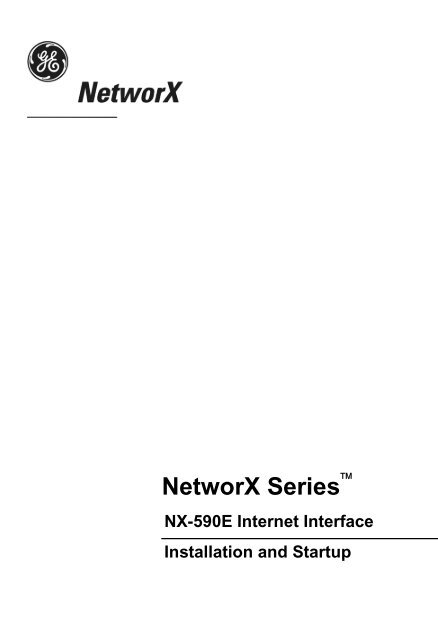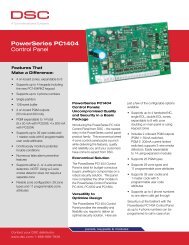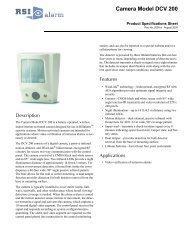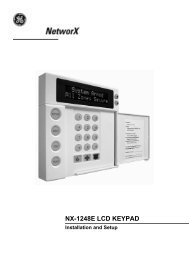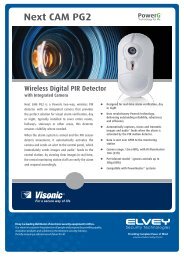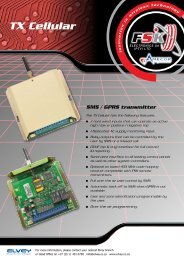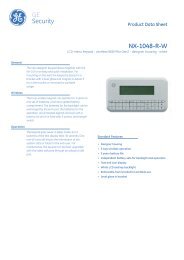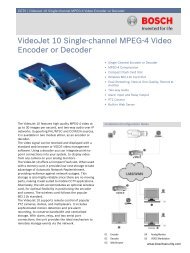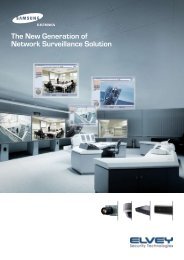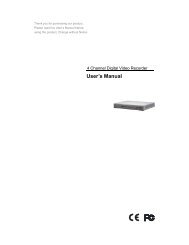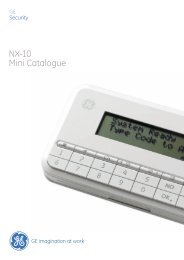NetworX Series - Elvey Security Technology
NetworX Series - Elvey Security Technology
NetworX Series - Elvey Security Technology
Create successful ePaper yourself
Turn your PDF publications into a flip-book with our unique Google optimized e-Paper software.
<strong>NetworX</strong> <strong>Series</strong> NX-590E Internet InterfaceInstallation and Startup
© 2005 GE <strong>Security</strong>All rights reserved.These instructions do not purport to cover all details or variations in equipment nor to provide everypossible contingency to be met during installation, operation, and maintenance. If further information isdesired or if particular problems arise that are not covered sufficiently for the purchaser’s purpose, thematter should be referred to GE <strong>Security</strong>, USA.This document contains proprietary information of GE <strong>Security</strong>, USA and is furnished to its customersolely to assist that customer in the installation, testing, operations, and/or maintenance of theequipment described. This document shall not be reproduced in whole or in part nor shall its contentsbe disclosed to any third party without the written approval of GE <strong>Security</strong>.Please refer to the current GE <strong>Security</strong> product catalog for detailed warranty information.Main 800-727-2339 Technical Support 888-432-3287Outside the US 903-845-6941 Sales & Literature 800-547-2556Main Fax 903-845-6811 Web: www.ge-security.comSymbol LegendWarningCautionNoteTipIndicates a procedure, practice, condition, or statement that, if notstrictly observed, could result in personal injury.* This symbol indicates electrical warnings and cautions.Indicates a procedure, practice, condition, or statement that, if notstrictly observed, could result in damage to or destruction ofequipment or property.** This symbol indicates general warnings and cautions.Indicates an essential or important procedure, instruction, condition,or statement.Indicates a user tip. Provides helpful information that is not normallydefined in regular use, but from an experienced user.2NX-590E Internet Interface
1. GENERAL DESCRIPTIONThe NX-590E is a dual microprocessor-controlled Internet/Intranet interface used to connect theto the OH Network Receiver. This interface allows any or all events from the <strong>NetworX</strong> controlseries (NX) to be reported over the Network. For warranty information, please refer to thecurrent GE <strong>Security</strong> Product catalog.2. ENCLOSURE INFORMATIONInside the can, several 2-holed insertion points have beenconstructed. This allows for either vertical or horizontalplacement of the modules. Notice that the insertionpoints have two sizes of holes -- a larger hole and asmaller hole.Diagram 1: The black plastic PCB guides are grooved onone edge where the PC Board will be seated. The end withthe half-moon protrusion fits into the larger hole. Thesmaller hole is for the screw.Diagram 2: Place the first black plastic PCB guide in thetop insertion point, grooved edge downward. The half-moonprotrusion will be in the large hole. It does not require force.Insert one of the provided screws into the smaller hole (frominside the can) to secure it in place. A screwdriver shouldreach through the notch that runs the length of the guide totighten the screw. The second PCB guide should bepositioned opposite of the first (grooved edge up) andplaced in the lower insertion point, using the sameprocedures described above. Once mounted, screw it insecurely.Diagram 3: The PC board should slide freely in thegrooves of both guides.3. MODULE ADDRESSThe Internet module has a fixed address of 79. When programming the interface module, enterthe Program Mode and select the device address as 79. (See "PROGRAMMING THEMODULE", page 7.)4NX-590E Internet Interface
4. ENROLLINGThe <strong>NetworX</strong> control panels have the ability to automatically find and store in memory thepresence of all keypads, zone expanders, wireless receivers, and any other device on thekeypad buss. This allows these devices to be supervised by the control panel. To enroll thedevices, enter the Program Mode of the NX control panel using the procedure outlined in the NXInstallation Manual. When the Program Mode is exited, the NX control will automatically enrollall the devices. The enrolling process takes about 12 seconds, during which time the AService@LED will illuminate. When using the LCD Keypad, the "Service Required" message will bedisplayed. User codes will not be accepted during the enrolling process. Once a module isenrolled, if the control panel does not detect it, the AService@ LED will illuminate.5. UNDERSTANDING THE LIGHTSThe Internet module has five (5) red LEDs along the front of the board and two more on the SIMmodule. These LEDs provide valuable information about the status of the Internet module andthe network as shown in the following table.LEDDS1DS3DS4DS5DS6DESCRIPTIONFlashes each time the NX-590E has an opportunity to access the <strong>NetworX</strong> bus. Itshould be flashing about two times each second.Flashes when it is waiting for a communication from the Ethernet Module.On when waiting for a reply from a <strong>NetworX</strong> buss device.Flashes when the NX-590E gets a packet from the Ethernet module.On when the bus has a message to send to the network. DS3 - DS6 will be off if the system is initialized, normal and waiting for a new event toreport.L1 (on SIM module) Flashes ON Ethernet ActivityL2 (on SIM module) Steady ON when Ethernet Link is established with the 10BT cable.The sixth LED is located toward the back of the board. It is used for hardware, andDS2will only glow dimly when connected to the NX8 / NX8-E control.6. WIRINGWire the 3-position terminal on the Internet module to the NX control as follows: Positive to KPPOS, COM to KP COM, and DATA to KP DATA. Connect the Ethernet Jack J16 (10BT) to a10BT Ethernet capable hub, router or gateway. Do not use a CASCADE or X port in crossovermode.MAXIMUM WIRE RUNLENGTH (IN FEET) 250 500 1000 2000 2500CONNECTED TO NX-8 / NX8-E 22 20 16 14 12CONNECTED TO NX-320E 22 18 16 12 12NX-590E Internet Interface 5
7. TERMINAL DESCRIPTIONTERMINALPOSCOMDATAJ16J6DESCRIPTIONConnect to the KP POS terminal of the panel. Current draw is 100 mAfor the NX-590E.Connect to the KP COM terminal of the panel.Connect to the KP DATA terminal of the panel.Connect to 10BT network hub using a CAT5 patch cable.Connect to RS-232 Modem when unit is delivered with serial software.8. CONNECTION DIAGRAM6NX-590E Internet Interface
9. PROGRAMMING THE MODULEA. USING THE LED KEYPADEntering the Program ModeTo enter the Program Mode, press [r]-[8]. At this time, the five function LEDs (Stay,Chime, Exit, Bypass, & Cancel) will begin to flash. Next, enter the "Go To ProgramCode" (Factory Default is [9]-[7]-[1]-[3]). If the "Go To Program Code" is valid, the"Service" LED will flash and the five function LEDs will illuminate steady. You are now inthe Program Mode and ready to select the module to program.Selecting the Module to Program:Next, enter the address of the Internet module, which is [7]-[9], followed by [#]. TheArmed LED will illuminate while it is waiting for a programming location to be entered.Factory Defaulting the ModuleIf this is the first time the module has been used or if you want to load the factorydefaults now enter [9]-[1]-[0]-[#]. The keypad will beep 3 times indicating that theloading is in progress. Remember you will erase any values you may have enteredpreviously.Programming a Location:Once the number of the module to be programmed has been entered, the "Armed" LEDwill illuminate while it is waiting for a programming location to be entered. Enter thedesired programming location, followed by the [#] key. The Armed LED will begin toflash while a programming location is being entered. If the location entered is a validlocation, the "Armed" LED will extinguish, the "Ready" LED will illuminate, and the zoneLED’s will show the binary data for the first segment of this location. To change thedata, enter the data followed by [r]. While entering new data, the "Ready" LED willbegin flashing to indicate a data change in process. The flashing will continue until thenew data is stored by pressing the [r] key. Upon pressing the [r] key, the keypad willadvance to the next segment and display its data. This procedure is repeated until thelast segment is reached. Pressing the [#] key will exit from this location, and the"Armed" LED will illuminate again waiting for a new programming location to be entered.To review the data, repeat the above procedure entering the [r] key without enteringdata first. Each time the [r] key is pressed the next segment is displayed. If thedesired location is the next sequential location, press the [POLICE] key. If the previouslocation is desired press the [FIRE] key. If the same location is desired press the[AUXILIARY] key. To review the data in a location, repeat the above procedure,pressing the [r] key without any numeric data entry. Each time the [r] key is pressed,the programming data of the next segment will be displayed for review.Exiting a Location:After the last segment of a location is programmed, pressing the [r] key will exit thatlocation, turn the "Ready" LED off and the "Armed" LED on. As before, you are nowready to enter another programming location. If an attempt is made to program aninvalid entry for a particular segment, the keypad sounder will emit a triple error beep(beep, beep, beep), and remain in that segment awaiting a valid entry.NX-590E Internet Interface 7
Exiting the Program Mode:When all the desired changes in programming have been made, it is time to exit theProgram Mode. Pressing the [Exit] key will exit this programming level.B. USING THE LCD KEYPADAll steps required for programming are the same as the aforementioned LED keypad.The LCD keypad display will prompt you for the data required. While in theprogramming mode, and not in a location, the number in parenthesis is the location youwere previously changing. For example, if the display reads, "Enter location, then #(5)", it is reminding you that location 5 was the last location you programmed. Referalso to "Programming Data" which follows.Table 9-1(**LCD KEYPAD ONLY**)No. No. No. No. No. No.00 16 P 32 5 48 l 64 " 80 03 C 19 S 35 8 51 o 67 % 83 ?04 D 20 T 36 9 52 p 68 & 84 @05 E 21 U 37 a 53 q 69 ' 85 [06 F 22 V 38 b 54 r 70 ( 86 ù07 G 23 W 39 c 55 s 71 ) 87 ]08 H 24 X 40 d 56 t 72 r 88 ^09 I 25 Y 41 e 57 u 73 + 89 _10 J 26 Z 42 f 58 v 74 , 90 `11 K 27 0 43 g 59 w 75 - 91 {12 L 28 1 44 h 60 x 76 . 92 |13 M 29 2 45 I 61 y 77 / 93 }14 N 30 3 46 j 62 z 78 : 94 º15 O 31 4 47 k 63 ! 79 ; 95 »C. PROGRAMMING DATAProgramming data is always one of three types. One type of data is numerical, whichcan take on values from 0 -15, 0 - F, or 0 -255 depending on the segment size. Theother type of data, feature selection data, is used to turn features on/off. It can also beused as character data for Internet names. Use the following procedures with thesedata types:Numerical DataNumerical data is programmed by entering a number from 0-255 on the numeric keys ofthe system keypad. To view the data in a location, a binary process is used. With thisprocess, the LED=s for zones 1 through 8 are utilized, and the numeric equivalents oftheir illuminated LED=s are added together to determine the data in a programminglocation. The numeric equivalents of these LED=s are as follows:Zone 1 LED = 1 Zone 3 LED = 4 Zone 5 LED = 16 Zone 7 LED = 64Zone 2 LED = 2 Zone 4 LED = 8 Zone 6 LED = 32 Zone 8 LED = 1288NX-590E Internet Interface
Example: If the numerical data to be programmed in a location is "66", press [6]-[6] onthe keypad. The LED=s for Zone 2 and Zone 7 will become illuminated indicating 66 isin that location (2 + 64 = 66). Once the data is programmed, press the [r] key to enterthe data and advance to the next segment of that location. After the last segment of alocation is programmed, pressing the [r] key will exit that location, turn the "Ready"LED off and the "Armed" LED on. As before, you are now ready to enter anotherprogramming location. If an attempt is made to program a number too large for aparticular segment, the keypad sounder will emit a triple beep, indicating an error, andremain in that segment awaiting a valid entry.Feature Selection DataFeature selection data will display the current condition (on or off) of eight featuresassociated with the programming location and segment selected. Pressing a button onthe touchpad (1 thru 8) that corresponds to the "feature number" within a segment willtoggle (on/off) that feature. Pressing any numeric key between [1] and [8] for selectionof a feature will make the corresponding LED illuminate (feature ON). Press the numberagain, and the LED will extinguish (feature OFF). You will see that numerous featurescan be selected from within one segment. For instance, if all eight features of asegment are desired, pressing [1]-[2]-[3]-[4]-[5]-[6]-[7]-[8] will turn on LED's 1 thru 8 asyou press the keys, indicating that those features are enabled. LCD Keypad Users: The numbers of the enabled features will be displayed.However, the features not enabled will display a hyphen (-). After the desiredsetting of features is selected for this segment, press the [r] key. This will enter thedata and automatically advance to the next segment of the location. When you are inthe last segment of a location and press the [r] to enter the data, you will exit thatlocation. This will now turn the "Ready" LED off and the "Armed" LED on. As before,you are now ready to enter another programming location.Character DataCharacter Data is used to enter LCD text when programming. An example of characterdata can be seen in programming locations 13-16 of this module, which takes the formof user@yourdomain.com. This information is programmed using the bottom line of thedisplay as a text editor. (Refer to the [r]-[9]-[2] feature in the NX148E manual.) Once acharacter location has been entered, the current data will be displayed on the bottomline. As is always the case, the top line will display the current location and segmentnumber. The five (5) function keys, as well as the up and down arrow to the right of thedisplay, are now used to edit the message prior to saving it back to the location storage.An underscore (_) in the display indicates the current cursor location. To move thecursor to the right, press the [r] key. To move the cursor to the left, press the [Cancel]key. To change the character at the current cursor location, press the Up or DownArrow until the desired character is displayed. An alternative and possibly fastermethod is to enter the 2-digit number found in Table 1.1 that corresponds to the desiredcharacter. To accept this character, press the [r] key. The character will remain andthe cursor will be advanced one space to the right. To insert spaces, press the [Stay]key. To delete characters, press the [Chime] key.NX-590E Internet Interface 9
10. PROGRAMMING THE LOCATIONSLOCATION 0 PROGRAMMING THE MODE (8 SEGMENTS FEATURE SELECTION DATA)Location 0 (zero) contains the module mode, i.e. system characteristics for operation on theInternet.. If Location 0 / Segment 1 / Option 1 below is enabled (NX-590E is the primaryreporting device and the control panel is backup). NOTE: The NX-4 and NX-6 (V1)control panels CANNOT act as a backup to the NX-590E module. All event categories should be disabled in Location 4 of the control panel (device 0).Failure to turn off these segments will cause events to be reported by both thecontrol panel and the NX-590E (dual reporting). Test reports should be enabled (Loc 4 / Seg 1 / Opt 7 in control panel). Failure toleave test reports enabled will result in the control panel NOT backing up events thatfail to communicate via the NX-590E. When properly set, test reports will be reportedby the control panel and the NX-590E.Segment 1Segment 21 = Use Control Dialer as Backup to TCP/IP and Email. Clear this option if thecontrol panel is primary/dual report. (Refer to note in box above.)2 = Enable if SIA; disable if Contact ID (factory default is ‘off’)3 = Use Receiver #2 as Backup4 = Send tag to on-site event recorder5-8 = Reserved1 = Enable site initiated downloading (r98 from a keypad).2 = Allow remote downloading to the system over the Internet. You shouldprogram this to 0 unless you absolutely have to program the system overthe network. Private networks behind a firewall may want to takeadvantage of this feature.3 = Use DHCP (IP address is static if 0) ( If this DHCP option is enabled,we strongly recommend that Polling in option 8 also be enabled.)4 – 7 = Reserved8 = Enable AA polling (poll every period of less than 5 minutes)Segments 3-8 ReservedLOCATION 1 PROGRAMMING PARTITIONS TO REPORT VIA INTERNET TO RECEIVER #1 (16SEGMENTS OF FEATURE SELECTION DATA)Location 1 contains the partition(s) that should be included when reporting over the Network. Ifyou wish to exclude any partition from reporting, simply turn off the LED corresponding to thatparticular partition. If the partition LED is off, no event from that partition will report via networkregardless of what is programmed elsewhere. Using Table 10-1 enter the correspondingnumber of the partition(s) to include for each type of report found in Segments 1 –16. Factorydefault is all partitions on.Table 10-11 = Partition 1 3 = Partition 3 5 = Partition 5 7 = Partition 72 = Partition 2 4 = Partition 4 6 = Partition 6 8 = Partition 810NX-590E Internet Interface
Segment 1 Alarms and Restores Segment 9 TampersSegment 2 Open/Close Segment 10 Short Circuit & Ground FaultSegment 3 Bypass Segment 11 Sensor LostSegment 4 Zone Trouble Segment 12 Sensor Low BatterySegment 5 Power Trouble (AC Failure or Segment 13 Expander TroubleLow Battery)Segment 6 Siren & Telephone Fault Segment 14 Failure To CommunicateSegment 7 Test Reports Segment 15 Zone Activity MonitorSegment 8 Program, Download & Log Full Segment 16 ReservedLOCATION 2 PROGRAMMING PARTITIONS TO REPORT VIA INTERNET TO RECEIVER #2 (16SEGMENTS OF FEATURE SELECTION DATA)Location 2 contains the partition(s) that should be included when reporting over the Network toReceiver #2. If you wish to exclude any partition from reporting, simply turn off the LEDcorresponding to that particular partition. If the partition LED is off, no event from that partitionwill report via network regardless of what is programmed elsewhere. Using Table 10-1 on page10, enter the corresponding number of the partition(s) to include for each type of report found inSegments 1 –16. Factory default is all partitions off.Segment 1 Alarms and Restores Segment 9 TampersSegment 2 Open/Close Segment 10 Short Circuit & Ground FaultSegment 3 Bypass Segment 11 Sensor LostSegment 4 Zone Trouble Segment 12 Sensor Low BatterySegment 5 Power Trouble (AC Failure or Segment 13 Expander TroubleLow Battery)Segment 6 Siren & Telephone Fault Segment 14 Failure To CommunicateSegment 7 Test Reports Segment 15 Zone Activity MonitorSegment 8 Program, Download & Log Full Segment 16 ReservedLOCATION 3 PROGRAMMING THE PARTITIONS REPORTING VIA EMAIL ACCOUNT #1 (16 SEGMENTSOF FEATURE SELECTION DATA)Location 3 contains the partition(s) that should be included when reporting over the Internet toEmail Account #1. If you wish to exclude any partition from reporting, simply turn off the LEDcorresponding to that particular partition. If the partition LED is not on, NO event from thatpartition will report via network regardless of what is programmed elsewhere. Use Table 10-1 onpage 10 to program which partitions to report for Segments 1–16. Factory default is allpartitions off.Segment 1 Alarms and Restores Segment 9 TampersSegment 2 Open/Close Segment 10 Short Circuit & GroundFaultSegment 3 Bypass Segment 11 Sensor LostSegment 4 Zone Trouble Segment 12 Sensor Low BatterySegment 5 Power Trouble (AC Failure or Segment 13 Expander TroubleLow Battery)Segment 6 Siren & Telephone Fault Segment 14 Failure To CommunicateSegment 7 Test Reports Segment 15 Zone Activity MonitorSegment 8 Program, Download & Log Full Segment 16 ReservedNX-590E Internet Interface 11
LOCATION 4 PROGRAMMING THE PARTITIONS REPORTING VIA EMAIL ACCOUNT #2 (16 SEGMENTSOF FEATURE SELECTION DATA)Location 4 contains the partition(s) that should be included when reporting over the to Emailaccount 2. If you wish to exclude any partition from reporting, simply turn off the bitcorresponding to that particular partition. If the partition LED is not on, NO event from thatpartition will report via network regardless of what is programmed elsewhere. Factory default isall partitions off.Segment 1 Alarms and Restores Segment 9 TampersSegment 2 Open/Close Segment 10 Short Circuit & Ground FaultSegment 3 Bypass Segment 11 Sensor LostSegment 4 Zone Trouble Segment 12 Sensor Low BatterySegment 5 Power Trouble (AC Failure or Segment 13 Expander TroubleLow Battery)Segment 6 Siren & Telephone Fault Segment 14 Failure To CommunicateSegment 7 Test Reports Segment 15 Zone Activity MonitorSegment 8 Program, Download & Log Full Segment 16 ReservedLOCATIONS 5 – 12RESERVEDLOCATIONS 13-16 RETURN EMAIL NAME FOR THIS MODULE (1 SEGMENT / 16 CHARACTERDATA)These locations are used to provide the name of this module in the form ofuser@yourdomain.com. This must be programmed for email, and the domain name must beone that your mail server accepts. Generally looking like any other user on the domain that youare connecting to works. Many mail servers reject emails from domains other than their own toprevent spamming.Location 13 Email Name of This Module (chars 1-16)Location 14 Email Name of This Module (chars 17-32)Location 15 Email Name of This Module (chars 33-48)Location 16 Email Name of This Module (chars 49-64)LOCATIONS 17-28RESERVEDLOCATIONS 29-36 EMAIL ACCOUNT NAMES (1 SEGMENT / 16 CHARACTER DATA)These locations are used to provide the name of email accounts you wish data to be sent to inthe form of user@yourdomain.com and otheruser@otherdomain.net these must be functionalemail accounts that are known to work. A large variety of devices can be utilized includingcomputers, cell phones, pagers and devices. For example, a dealer may want Troubles mailedto his cell phone, Openings and Closings emailed to his home computer, and Alarms sent to thecentral station. NOTES: 1) Make sure the account works before you program it. 2) Keep goodrecords since email addresses change more often than most other items.Location 29 Name of Email Account 1 (chars 1-16)Location 30 Name of Email Account 1 (chars 17-32)Location 31 Name of Email Account 1 (chars 33-48)Location 32 Name of Email Account 1 (chars 49-64)Location 33 Name of Email Account 2 (chars 1-16)Location 34 Name of Email Account 2 (chars 17-32)Location 35 Name of Email Account 2 (chars 33-48)Location 36 Name of Email Account 2 (chars 49-64)12NX-590E Internet Interface
LOCATIONS 37-40 NAME FOR YOUR EMAIL SERVER (1 SEGMENT / 16 CHARACTER DATA)These locations are used to provide the server for email in the form of mail.yourdomain.com.This must be programmed for email. Confirm that this server accepts email from the domainname of the NX-590E since many mail servers reject emails from domains other than their ownto prevent spamming.Location 37 Name of Mail Server (chars 1-16)Location 38 Name of Mail Server (chars 17-32)Location 39 Name of Mail Server (chars 33-48)Location 40 Name of Mail Server (chars 49-64)LOCATIONS 41 - 44RESERVEDLOCATIONS 45- 52 IP ADDRESSES (1 SEGMENT DECIMAL DATA)If you turned on static IP's instead of Dynamic in location 0, you will need to program locations45, 52, and 54 with the appropriate IP addresses. Otherwise, the NX-590E will use the assignedDHCP ServerLocation 45 IP Address For This ModuleLocation 46 IP Address For Primary ReceiverLocation 47 IP Address For Secondary ReceiverLocation 48 IP Address For On-Site Event RecorderLocation 49 ReservedLocation 50 ReservedLocation 51 IP Address Mail ServerLocation 52 IP Address of Gateway It is necessary to power down the NX-590E module and power it backup in order initialize the new IP address.LOCATION 53 IP ADDRESS FOR DOWNLOAD COMPUTER (1 SEGMENT DECIMAL DATA)Location 53 contains the address for the download computer. The default is 0.0.0.0.LOCATION 54 SUBNET MASK (1 SEGMENT DECIMAL DATA)Location 54 contains the subnet mask (typically 255.255.255.0). However, we suggest you callyour Network administrator. This location must be configured so that all IP addresses up to andincluding the local gateway are allowed. When using cable modem/DSL, this will generally bethe same as the computer. To obtain your IP address, gateway, and subnet mask, use one ofthe following steps: For Windows 9X and Windows ME -- At the DOS prompt, type “ipconfig” For Windows 2000 & XP -- At the COMMAND prompt, type “ipconfig”LOCATIONS 55-57 PORT ADDRESSES (4 SEGMENTS DECIMAL DATA)These locations contain the IP ports used by the TCP/IP receiver. You should never changethese except as directed by your central station provider.Location 55Receiver Alarm PortLocation 56Receiver Download PortLocation 57Email PortLOCATIONS 58-59RESERVEDNX-590E Internet Interface 13
LOCATION 60 SIA OR CONTACT ID ACCOUNT NUMBER (8 SEGMENTS HEX DATA)This location contains the SIA or Contact ID account number. Contact your usual source ofaccount number and dial number for installations. It is important to add leading zeros to create an 8-digit number.LOCATION 61 PHONE LINE RECEIVER NUMBER (4 SEGMENTS DECIMAL DATA)This location contains the phone line receiver number associated with this account. Contact yourusual source of account number and dial number for installations.LOCATION 62 LINE NUMBER (4 SEGMENTS DECIMAL DATA)This location contains the line number associated with this account. Contact your usual sourceof account number and dial number for installations. If you have a Sure-Gard receiver with lineA, enter as line 11.LOCATION 63 TIMERS AND COUNTERS (3 SEGMENTS DECIMAL DATA)This location sets the number of attempts and the number of seconds to access the network.Ordinarily, these segments should not be changed. The defaults are balanced to provide anumber of network attempts that satisfy UL requirement if the alarm must be dialed back. Theunit will make the number of attempts in Segment 1 until the number of seconds in Segment 2 isexhausted. If UL Polling is turned on, the time is this number plus 30 seconds. The default willyield a polling time of less than 90 seconds under most conditions.Segment 1 Number of network attempts (Factory default is 2)Segment 2Time in seconds for overall network attempt( Minimum 30 seconds. Factory default is 30)Segment 3 Polling time in seconds (Factory default is 10)LOCATIONS 63 - 94RESERVED14NX-590E Internet Interface
11. PROGRAMMING WORKSHEETDEFAULTS ARE SHOWN IN BOLD ITALICSLOC PAGE DESCRIPTION DEFAULT PROGRAMMING0 10 MODULE MODE OF OPERATIONSEG 11 = Use control dialer as backup to TCP/IP and email2 = Backup Format (Off = CID, On = SIA)3 = Use Receiver #2 as Backup4 = Send Tag to On-Site Event Recorder5-8 = ReservedSEG 21 = Enable site initiated downloading (98 fromkeypad)2 = Enable remote initiated downloading3 = Use DHCP services (static IP of unit if OFF) If enabled, it is recommended that option 8also be enabled.4 - 7 = Reserved8 = Polling enable (for UL AA)SEG 3-8 RESERVEDOFFOFFOFFOFF-----ONONOFF----OFF1 10 PARTITIONS TO REPORT BY INTERNET TO RECEIVER #11 = Alarms and Restores 2 = Open/Close 3 = Bypass 4 = Zone Trouble 5 = Power Trouble (AC Failure or Low Battery) 6 = Siren & Telephone Fault 7 = Test Reports 8 = Program, Download & Log Full 9 = Tampers 10 = Short Circuit & Ground Fault 11 = Sensor Lost 12 = Sensor Low Battery 13 = Expander Trouble 14 = Failure to Communicate 15 = Zone Activity Monitor 16 = Reserved0000000000000000000000000000000000000000000000000000000000000000000000000000000000000000000000000000000000000000000000000000000000000000000000000000000000000000000000000000000000000000000000000000000000000000000000000000000000000000000000000000000000000000000000000000000000000000000000000000000000000000000000000000000000000000000000000000000000000000000000000000000000000000000000000000000000000000000000000000000000000000000000000000000000000000000000000000000000000000000000000000000000000000000000000000000000000000000000000000000000000000000000000000000000000000000000000000000000000000000000000000000000000000000000000000000000000000000000000000000000000000000000000000000000000000000000000000000000000000000000000000000000000000000000000000000000000000000000000000000000000000000000000000000000000000000000000000000000000000000000000000000000000000000000000000000000000000000000000000000000000000000000000000000000000000000000000000000000000000000000000000000000000000000000000000000000000000000000000000000000000000000000000000000000000000000000000000000000000000000000000000000000000000000000000000000000000000000000000000000000000000000000000000000000000000000000000000000000000000000000000000000000000000000000000000000000000000000000000000000000000000000000000000000000000000000000000000000000000000000000000000000000000000000000000000000000000000000000000000000000000000000000000000000000000000000000000000000000000000000000000000000000000000000000000000000000000000000000000000000000000000000000000000000000000000000000000000NX-590E Internet Interface 15
00000000000000000000000000000000000000000000000000000000000000000000000000000000000000000000000000000000000000000000000000000000000 000000000000000000000000000000000000000000000000000000000000000000000000000000000000000000000000000000000000000000000000000000000000000000000000000000000000000000000000000000000LOC PAGE DESCRIPTION DEFAULT PROGRAMMING2 11 PARTITIONS TO REPORT BY INTERNET TO RECEIVER #2000000000000000000000000000000000000000000000000000000000000000000000000000000000000000000000000000000000000000000000000000000000000000000000000000000000000000000000000000000000000000000000000000000000000000000000000000000000000000000000000000000000000000000000000000000000000000000000000000000000000000000000000000000000000000000000000000000000000000000000000000000000000000000000000000000000000000000000000000000000000000000000000000000000000000000000000000000000000000000000000000000000000000000000000000000000000000000001 = Alarms and Restores 2 = Open/Close 3 = Bypass 4 = Zone Trouble 5 = Power Trouble (AC Failure or Low Battery) 6 = Siren & Telephone Fault 7 = Test Reports 8 = Program, Download & Log Full 9 = Tampers 10 = Short Circuit & Ground Fault 11 = Sensor Lost 12 = Sensor Low Battery 13 = Expander Trouble 14 = Failure to Communicate 15 = Zone Activity Monitor 16 = Reserved3 11 PARTITIONS TO REPORT BY INTERNET TO EMAIL ACCOUNT #11 = Alarms and Restores 2 = Open/Close 3 = Bypass 4 = Zone Trouble 5 = Power Trouble (AC Failure or Low Battery) 6 = Siren & Telephone Fault 7 = Test Reports 8 = Program, Download & Log Full 9 = Tampers 10 = Short Circuit & Ground Fault 11 = Sensor Lost 12 = Sensor Low Battery 13 = Expander Trouble 14 = Failure to Communicate 15 = Zone Activity Monitor 16 = Reserved4 12 PARTITIONS TO REPORT BY EMAIL ACCT #2 TO RECEIVER1 = Alarms and Restores 2 = Open/Close 3 = Bypass 4 = Zone Trouble 5 = Power Trouble (AC Failure or Low Battery) 6 = Siren & Telephone Fault 7 = Test Reports 8 = Program, Download & Log Full 9 = Tampers 10 = Short Circuit & Ground Fault 11 = Sensor Lost 12 = Sensor Low Battery 13 = Expander Trouble 14 = Failure to Communicate 15 = Zone Activity Monitor 16 = Reserved5-12 12 RESERVED13 12 EMAIL NAME OF THIS MODULE (char 1-16)000000000000000000000000000000000000000000000000000000000000000000000000000000000000000000000000000000000000000000000000000000000000000000000000000000000000000000000000000000000000000000000000000000000000000000000000000000000000000000000000000000000000000000000000000000000000000000000000000000000000000000000000000000000000000000000000000000000000000000000000000000000000000000000000000000000000000000000000000000000000000000000000000000000000000000000000000000000000000000000000000000000000000000000000000000000000000000000000000000000000000000000000000000000000000000000000000000000000000000000000000000000000000000000000000000000000000000000000000000000000000000000000000000000000000000000000000000000000000000000000000000000000000000000000000000000000000000000000000000000000000000000000000000000000000000000000000000000000000000000000000000000000000000000000000000000000000000000000000000000000000000000000000000000000000000000000000000000000000000000000000000000000000000000000000000000000000000000000000000000000000000000000000000000000000000000000000000000000000000000000000000000000000000000000000000000000000000000000000000000000000000000000000000000000000000000000000000000000000000000000000000000000000000000000000000000000000000000000000000000000000000000000000000000000000000000000000000000000000000000000000016NX-590E Internet Interface
00000000000000000000000000000000000000000000000000000000000000000000000000000000000000000000000000000000000000000000000000000000000 00000000000000000000000000000000000000000000000000000000000000000000000000000000000000000000000000000000000000000000000000000000000000000000000000000000000000000000000000000000000000000000000000000000000000000000000000000000000000000000000000000000000000000000000000000000000000000000000000000000000000000000 000000000000000000000000000000000000000000000000000000000000000000000000000000000000000000000000000000000000000000000000000000000000000000000000000000000000000000000000000000000LOC PAGE DESCRIPTION DEFAULT PROGRAMMING14 12 EMAIL NAME OF THIS MODULE (char 17-32)15 12 EMAIL NAME OF THIS MODULE (char 33-48)16 12 EMAIL NAME OF THIS MODULE (char 49-64)17-28 12 RESERVED29 12 EMAIL ACCOUNT #1 (char 1-16)30 12 EMAIL ACCOUNT #1 (char 17-32)31 12 EMAIL ACCOUNT #1 (char 33-48)32 12 EMAIL ACCOUNT #1 (char 49-64)33 12 EMAIL ACCOUNT #2 (char 1-16)34 12 EMAIL ACCOUNT #2 (char 17-32)35 12 EMAIL ACCOUNT #2 (char 33-48)36 12 EMAIL ACCOUNT #2 (char 49-64)37 13 MAIL SERVER (char 1-16)38 13 MAIL SERVER (char 17-32)39 13 MAIL SERVER (char 33-48)40 13 MAIL SERVER (char 49-64)41-44 13 RESERVED45 13 IP ADDRESS FOR THIS MODULE 0.0.0.046 13 IP ADDRESS FOR PRIMARY RECEIVER 0.0.0.047 13 IP ADDRESS FOR SECONDARY RECEIVER 0.0.0.048 13 IP ADDRESS FOR ON-SITE EVENT RECORDER 0.0.0.049-50 13 RESERVED51 13 IP ADDRESS MAIL SERVER 0.0.0.052 13 IP ADDRESS OF GATEWAY 0.0.0.053 13 IP ADDRESS FOR DOWNLOAD COMPUTER 0.0.0.054 13 IP ADDRESS SUBNET MASK 255.255.255.055 13 RECEIVER ALARM PORT 9-9-9-956 13 RECEIVER DOWNLOAD PORT 9-9-9-857 13 EMAIL PORT 0-0-2-558-59 13 RESERVED60 14 ACCOUNT NUMBER (Hex) Add leading zeros!!000000000000000000000000000000000000000000000000000000000000000000000000000000000000000000000000000000000000000000000000000000000000000000000000000000000000000000000000000000000000000000000000000000000000000000000000000000000000000000000000000000000000000000000000000000000000000000000000000000000000000000000000000000000000000000000000000000000000000000000000000000000000000000000000000000000000000000000000000000000000000000000000000000000000000000000000000000000000000000000000000000000000000000000000000000000000000000000000000000000000000000000000000000000000000000000000000000000000000000000000000000000000000000000000000000000000000000000000000000000000000000000000000000000000000000000000000000000000000000000000000000000000000000000000000000000000000000000000000000000000000000000000000000000000000000000000000000000000000000000000000000000000000000000000000000000000000000000000000000000000000000000000000000000000000000000000000000000000000000000000000000000000000000000000000000000000000000000000000000000000000000000000000000000000000000000000000000000000000000000000000000000000000000000000000000000000000000000000000000000000000000000000000000000000000000000000000000000000000000000000000000000000000000000000000000000000000000000000000000000000000000000000000000000000000000000000000000000000000000000000000000000000000000000000000000000000000000000000000000000000000000000000000000000000000000000000000000000000000000000000000000000000000000000000000000000000000000000000000000000000000000000000000000000000000000000000000000000000000000000000000000000000000000000000000000000000000000000000000000000000000000000000000000000000000000000000000000000000000000000000000000000000000000000000000000000000000000000000000000000000000000000000000000000000000000000000000000000000000000000000000000000000000000000000000000000000000000000000000000000000000000000000000000000000000000000000000000000000000000000000000000000000000000000000000000000000000000000000000000000000000000000000000000000000000000000000000000000000000000000000000000000000000000000000000000000000000000000000000000000000000000000000000000000000000000000000000000000000000000000000000000000000000000000000000000000000000000000000000000000000000000000000000000000000000000000000000000000000000000000000000000000000000000000000000000000000000000000000000000000000000000000000000000000000000000000000000000000000000000000000000000000000000000000000000000000000000000000000000000000000000000000000000000000000000000000000000000000000000000000000000000000000000000000000000000000000000000000000000000000000000000000000000000000000000000000000000000000000000000000000000000000000000000000000000000000000000000000000000000000000000000000000000000000000000000000000000000000000000000000000000000000000000000000000000000000000000000000000000000000000000000000000000000000000000000000000000000000000000000000000000000000000000000000000000000000000000000000000000000000000000000000000000000000000000000000000000000000000000000000000000000000000000000000000000000000000000000000000000000000000000000000000000000000000000000000000000000000000000000000000000000000000000000000000000000000000000000000000000000000000000000000000000000000000000000000000000000000000000000000000000000000000000000000000000000000000000000000000000000000000000000000000000000000000000000000000000000000000000000000000000000000000000000000000000000000000000000000000000000000000000000000000000000000000000000000000000000000000000000000000000000000000000000000000000000000000000000000000000000000000000000000000000000000000000000000000000000000000000000000000000000000000000000000000000000000000000000000000000000000000000000000000000000000000000000000000000000000000000000000000000000000000000000000000000000000000000000000000000000000000000000000000000000000000000000000000000000000000000000000000000000000000000000000000000000000000000000000000000000000000000000000000000000000000000000000000000000000000000000000000000000000000000000000000000000000000000000000000000000000000000000000000000000000000000000000000000000000000000000000000000000000000000000000000000000000000000000000000000000000000000000000000000000000000000000000000000000000000000000000000000000000000000000000000000000000000000000000000000000000000000000000000000000000000000000000000000000000000000000000000000000000000000000000000000000000000000000000000000000000000000000000000000000000000000000000000000000000000000000000000000000000000000000000000000000000000000000000000000000000000000000000000000000000000000000000000000000000000000000000000000000000000000000000000000000000000000000000000000000000000000000000000000000000000000000000000000000000000000000000000000000000000000000000000000000000000000000000000000000000000000000000000000000000000000000000000000000000000000000000000000000000000000000000000000000000000000000000000000000000000000000000000000000000000000000000000000000000000000000000000000000000000000000000000000000000000000000000000000000000000000000000000000000000000000000000000000000000000000000000000000000000000000000000000000000000000000000000000000000000000000000000000000000000000000000000000000000000000000000000000000000000000000000000000000000000000000000000000000000000000000000000000000000000000000000000000000000000000000000000000000000000000000000000000000000000000000000000000000000000000000000000000000000000000000000000000000000000000000000000000000000000000000000000000000000000000000000000000000000000000000000000000000000000000000000000000000000000000000000000000000000000000000000000000000000000000000000000000000000000000000000000000000000000000000000000000000000000000000000000000000000000000000000000000000000000000000000000000000000000000000000000000000000000000000000000000000000000000000000000000000000000000000000000000000000000000000000000000000000000000000000000000000000000000000000000000000000000000000000000000000000000000000000000000000000000000000000000000000000000000000000000000000000000000000000000000000000000000000000000000000000000000000000000000000000000000000000000000000000000000000000000000000000000000000000000000000000000000000000000000000000000000000000000000000000000000000000000000000000000000000000000000000000000000000000000000000000000000000000000000000000000000000000000000000000000000000000000000000000000000000000000000000000000000000000000000000000000000000000000000000000000000000000000000000000000000000000000000000000000000000000000000000000000000000000000000000000000000000000000000000000000000000000000000000000000000000000000000000000000000000000000000000000000000000000000000000000000000000000000000000000000000000000000000000000000000000000000000000000000000000000000000000000000000000000000000000000000000000000000000000000000000000000000000000000000000000000000000000000000000100061 14 RECEIVER NUMBER (Decimal) 000162 14 LINE NUMBER (Decimal) 000163 14 TIMERS & COUNTERS USED64-94 14 RESERVEDSEG 1 – Number of network attempts 2SEG 2 – Time in seconds for overall networkattemptSEG 3 – Polling time in seconds 100000000000000000000000000000000000000000000000000000000000000000000000000000000000000000000000000000000000000000000000000000000000000000000000000000000000000000000000000000000000000000000000000000000000000000000000000000000000000000000000000000000000000000000000000000000000000000000000000000000000000000000030NX-590E Internet Interface 17
12. FREQUENTLY ASKED QUESTIONSDo I have to setup an IP address for the NX-590E module?Absolutely, you must setup a static IP address or use DHCP to get a dynamic IP address. Failure todo so will result in the NX-590E not able to function at all.What locations I need to setup to assign a static IP to the NX-590E module?Location 0, Segment 2, Bit 3 must be set to 0Location 45, must be set to the assigned IP address like 3.18.147.166Location 52, must be set to the Assigned Gateway address like 3.18.144.1Location 54, must be set to the Subnet Mask like 255.255.252.0IP address, Gateway address, and Subnet mask are parameter your IT person would be able toprovide for the location where the NX-590E would be installed.What locations I need to setup to assign a dynamic IP using DHCP to the NX-590E module?Location 0, Segment 2, Bit 3 must be set to 1Locations 45, 52, and 54 are not used in this scenario.Your IT person would be able to tell you if the network supports dynamic IP addressing for yourinstallation.How do I setup the NX-590E to send events as e-mail messages only?Location 1, Segments 1-16 must be set to ‘-‘ to disable reporting to Receiver 1Location 2, Segments 1-16 must be set to ‘-‘ to disable reporting to Receiver 2Location 3, Segments 1-16 must enable needed segments in used partitions (see NX-590EInstallation and Startup document for segments definition) for email 1; otherwise must be set to ‘-‘ todisable reportingLocation 4, Segments 1-16 must enable needed segments in used partitions (see NX-590EInstallation and Startup document for segments definition) for email 2; otherwise must be set to ‘-‘ todisable reportingLocations 3-16, a 64 characters space for the ‘From:’ field in the e-mail message. A valid name likefieldpanel1@yourdomain.com should be used.Locations 29-32, a 64 characters space for the ‘To:’ field in the e-mail message. A valid name likejohnd@yourdomain.com should be used. This for e-mail 1.Locations 33-36, a 64 characters space for the ‘To:’ field in the e-mail message. A valid name likejohnd@yourdomain.com should be used. This for e-mail 2.Locations 37-40 a 64 characters space for the mail server name. A valid name likemailhost.indsys.ge.com should be used.Location 51, mail server IP addressLocation 57, Email port, default is 025.How do I setup the NX-590E to send events to Receiver 1 only?Location 1, Segments 1-16 must enable needed segments in used partitions (see NX-590EInstallation and Startup document for segments definition)Location 2, Segments 1-16 must be set to ‘-‘ to disable reporting to Receiver 2Location 3, Segments 1-16 must be set to ‘-‘ to disable reporting to Email 1Location 4, Segments 1-16 must be set to ‘-‘ to disable reporting to Email 2Location 46, IP address for Receiver 1Location 55, Receiver Alarm Port numberHow do I setup the NX-590E to send events to Receiver 2 only?Location 1, Segments 1-16 must be set to ‘-‘ to disable reporting to Receiver 1Location 2, Segments 1-16 must enable needed segments in used partitions (see NX-590EInstallation and Startup document for segments definition)Location 3, Segments 1-16 must be set to ‘-‘ to disable reporting to Email 1Location 4, Segments 1-16 must be set to ‘-‘ to disable reporting to Email 2Location 47, IP Address for Receiver 2Location 55, Receiver Alarm Port number18NX-590E Internet Interface
How much bandwidth will the NX panel will utilize on my network?The NX panel event message size is 54 bytes and the poll message is 20 bytes. Typically, a panelmight generate an Arm and a disarm event one a day and an alarm when one occurs. The pollmessage could be sent at a rate of once a second to once every 255 seconds. The default setting isevery 10 seconds. So, the NX panel adds very negligible load on the network.13. GLOSSARYDHCPE-MAILETHERNETShort for Dynamic Host Configuration Protocol, a protocol for assigning dynamic IPaddresses to devices on a network. With dynamic addressing, a device can have adifferent IP address every time it connects to the network. In some systems, the device’s IPaddress can even change while it is still connected. DHCP also supports a mix of static anddynamic IP addresses.Dynamic addressing simplifies network administration because the software keeps track ofIP addresses rather than requiring an administrator to manage the task. This means that anew computer can be added to a network without the hassle of manually assigning it aunique IP address. Many ISPs use dynamic IP addressing for dial-up users.DHCP client support is built into Windows 95 and NT workstation. NT 4 server includesboth client and server support.Short for electronic mail, the transmission of messages over communications networks.Another common spelling for e-mail is email. The messages can be notes entered from thekeyboard or electronic files stored on disk. Most mainframes, minicomputers, and computernetworks have an e-mail system. Some electronic-mail systems are confined to a singlecomputer system or network, but others have gateways to other computer systems,enabling users to send electronic mail anywhere in the world. The same message can besent to several users at once. This is called broadcasting. Companies that are fullycomputerized make extensive use of e-mail because it is fast, flexible, and reliable.All online services and Internet Service Providers (ISPs) offer e-mail, and most also supportgateways so that you can exchange mail with users of other systems. Usually, it takes onlya few seconds or minutes for mail to arrive at its destination. This is a particularly effectiveway to communicate with a group because you can broadcast a message or document toeveryone in the group at once.Although different e-mail systems user different formats, there are some emergingstandards that are making it possible for users on all systems to exchange messages. Inthe PC world, an important e-mail standard is MAPI. The CCITT standards organizationhas develop the X.400 standard, which attempts to provide a universal way of addressingmessages. To date, though, the de facto addressing standard is one used by the Internetsystem because almost all e-mail systems have an Internet gateway.A local-area network (LAN) architecture developed by Xerox Corporation in cooperationwith DEC and Intel in 1976. Ethernet uses a bus or star topology and supports datatransfer rates of 10Mbps. The Ethernet specification served as the basis for the IEEE 802.3standard, which specifies the physical and lower software layers. Ethernet uses theCSMA/CD access method to handle simultaneous demands. It is one of the most widelyimplemented LAN standards.A newer version of Ethernet, called 100Base-T (or Fast Ethernet) supports data transferrates of 100Mbps. And the newest version, Gigabit Ethernet supports data rates of 1gigabit (1,000 megabits) per second.NX-590E Internet Interface 19
FIREWALLA system designed to prevent unauthorized access to or from a private network. Firewallscan be implemented in both hardware and software, or a combination of both. Firewalls arefrequently used to prevent unauthorized Internet users from accessing private networksconnected to the Internet, especially intranets. All messages entering or leaving theintranet pass through the firewall, which examines each message and blocks those that donot meet the specified security criteria.There are several types of firewall techniques: Packet filter: Looks at each packet entering or leaving the network and accepts orrejects it based on user-defined rules. Packet filtering is fairly effective andtransparent to users, but it is difficult to configure. In addition, it is susceptible to IPspoofing. Application gateway: Applies security mechanisms to specific applications, suchas FTP and Telnet servers. This is very effective, but can impose performancedegradation. Circuit-level gateway: Applies security mechanisms when a TCP or UDPconnection is established. Once the connection has been made, packets can flowbetween the hosts without further checking. Proxy server: Intercepts all messages entering and leaving the network. Theproxy server effectively hides the true network addresses.In practice, many firewalls use two or more of these techniques in concert. A firewall isconsidered a first line of defense in protecting private information. For greater security, datacan be encrypted.GATEWAYIPIPADDRESSIn networking, a combination of hardware and software that links two different types ofnetworks. Gateways between e-mail systems, for example, allow users on different e-mailsystems to exchange messages.Abbreviation of Internet Protocol, pronounced as two separate letters. IP specifies theformat of packets, also called datagrams, and the addressing scheme. Most networkscombine IP with a higher-level protocol called Transport Control Protocol (TCP), whichestablishes a virtual connection between a destination and a source.IP by itself is something like the postal system. It allows you to address a package anddrop it in the system, but there’s no direct link between you and the recipient. TCP/IP, onthe other hand, establishes a connection between two hosts so that they can sendmessages back and forth for a period of time.The current version of IP is IPv4. A new version, called IPv6 or IPng, is underdevelopment.An identifier for a computer or device on a TCP/IP network. Networks using the TCP/IPprotocol route messages based on the IP address of the destination. The format of an IPaddress is a 32-bit numeric address written as four numbers separated by periods. Eachnumber can be zero to 255. For example, 1.160.10.240 could be an IP address.Within an isolated network, you can assign IP address at random as long as each one isunique. However, connecting a private network to the Internet requires using registered IPaddresses (called Internet addresses) to avoid duplicates.The four numbers in an IP address are used in different ways to identify a particular networkand a host on that network. The InterNIC Registration Service assigns Internet addressesfrom the following three classes. Class A – supports 16 million hosts on each of 127 networks Class B – supports 65,000 hosts on each of 16,000 networks20NX-590E Internet Interface
Class C – supports 254 hosts on each of 2 million networksThe number of unassigned Internet addresses is running out, so a new classless schemecalled CIDR is gradually replacing the system based on classes A, B, and C and is tied toadoption of IPv6.NETWORKA group of two or more computer systems linked together. There are many types ofcomputer networks, including:Local-area networks (LANs): The computers are geographically close together (that is, inthe same building). Most LANs connect workstations and personal computers. Each node(individual computer in a LAN has its own CPU with which it executes programs, but it isalso able to access data and devices anywhere on the LAN. This means that many userscan share expensive devices, such as laser printers, as well as data. Users can also usethe LAN to communicate with each other, by sending e-mail or engaging in chat sessions.LANs are capable of transmitting data at very fast rates, much faster than data can betransmitted over a telephone line; but the distances are limited, and there is also a limit onthe number of computers that can be attached to a single LAN. Wide-area networks (WANs): A computer network that spans a relatively largegeographical area. Typically, a WAN consists of two or more local-area networks(LANs). Computers connected to a WAN are often connected through publicnetworks, such as the telephone system. They can also be connected throughleased lines or satellites. The largest WAN in existence is the Internet.In addition to these types, the following characteristics are also used to categorize differenttypes of networks:Topology: The geometric arrangement of a computer system. Common topologiesinclude a bus, star, and ring.Protocol: The protocol defines a common set of rules and signals that computerson the network use to communicate. One of the most popular protocols for LANs iscalled Ethernet. Another popular LAN protocol for PCs is the IBM token-ringnetwork.Architecture: Networks can be broadly classified as using either peer-to-peer orclient/server architecture.Computers on a network are sometimes called nodes. Computers and devices that allocateresources for a network are called servers.TCPAbbreviation of Transmission Control Protocol, and pronounced as separate letters. TCP isone of the main protocols in TCP/IP networks. Whereas the IP protocol deals only withpackets, TCP enables two hosts to establish a connection and exchange streams of data.TCP guarantees delivery of data and also guarantees that packets will be delivered in thesame order in which they were sent.NX-590E Internet Interface 21
FCC (CLASS B) INFORMATIONThis equipment has been tested and found to comply with the limits for a Class B digital device, pursuant toPart 15 of the FCC Rules. Operation is subject to the following two conditions: (1) This device may notcause harmful interference, and (2) this device must accept any interference received, includinginterference that may cause undesired operation.These limits are designed to provide reasonable protection against harmful interference when theequipment is operated in a residential environment. This equipment generates, uses, and can radiate radiofrequency energy and, if not installed and used in accordance with the instruction manual, may causeharmful interference to radio communications. However, there is no guarantee that interference will notoccur in a particular installation. If this equipment does cause harmful interference to radio or televisionreception, which can be determined by turning the equipment off and on, the user is encouraged to try tocorrect the interference by one or more of the following measures:• Reorient or relocate the receiving antenna.• Increase the separation between the equipment and receiver.• Connect the equipment into an outlet on a circuit different from that to which the receiver is connected.• Consult the dealer or an experienced radio/TV technician for help.Changes or modifications not expressly approved by the party responsible for compliance (manufacturer)could void the user’s authority to operate the equipment.This Class B digital apparatus complies with Canadian ICES-003.PRODUCTS WHICH HAVE THE CE MARK ATTACHEDMANUFACTURERSDECLARATION OFCONFORMITYForProduct identification:Model/typeNX-590ECategoryTCP-IP Internet moduleBrand InterlogiX / Aritech / SLC Technologies / Sentrol / ESL / ITI / Caddx /Casi RuscoManufacturer:EU representativeConcerningA sample of the product hasbeen tested by:Test report referenceApplied standardsGE Interlogix1420 N Main; Gladewater, TX 75647 USAGE Interlogix B.V.EMCCompliance Engineering Ireland Ltd. Raytown, Ratoath road,Oshbourne, C.O. Meath, Ireland.GE Interlogix Ireland Ltd. Unit 2008, Orchard Ave, City WestBusiness Campus. Naas; Road Dublin 24, Ireland.03E1089-1, 03DREMC002, GE-ILX CE qual. Plan: 03DUBCE5012-1EN50130-4 (1995) +A1(1998)EN50081-1(1992) ; EN55022: 1998 +A1(2000)Equipment class identifier (RF products falling under the scope of R&TTE)X Not Applicable None (class 1) (class 2)Means of conformityWe declare under our sole responsibility that this product is in conformity with Directive 89/336/EEC (EMC),and 93/68/EEC (Marking) based on test results using harmonized standards in accordance with theDirectives mentioned.22NX-590E Internet Interface
SYSTEM NOTESNX-590E Internet Interface 23
14. SPECIFICATIONSOPERATING POWERCURRENT DRAWOPERATING TEMPERATUREDIMENSIONS12VDC Supplied from NX-4, NX-4V2, NX-6, NX-6V2, NX-8,NX-8V2, NX-8E or NX-320E120 mA during communication / 90mA standby32 to 120 degrees F6.0" Wide3.25" High1.0" DeepSHIPPING WEIGHT1 lb.Main 800-727-2339 Technical Support 888-437-3287Outside the US 903-845-6941 Sales & Literature 800-547-2556Main Fax 903-845-6811 Web: www.gesecurity.comNX590E INSTALLATION MANUALNX590EID05 REV. D (MAR 2005)


